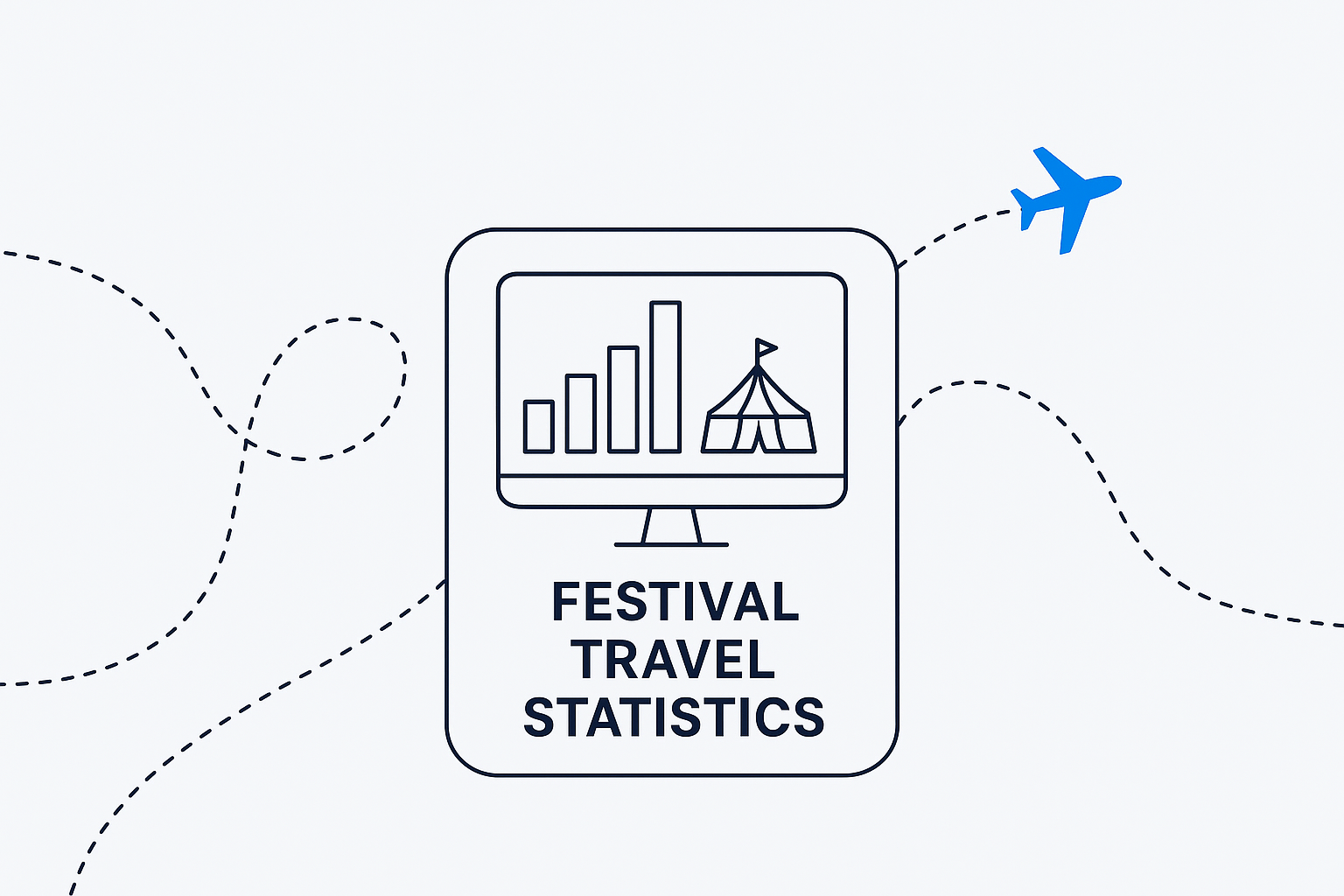Festival travel has become one of the fastest-growing segments of global tourism, with over 30 million people worldwide traveling each year primarily to attend festivals.
In 2024 alone, the global event tourism market was valued at $1.52 trillion, a figure that highlights just how powerful cultural gatherings like music and arts festivals have become.
From Coachella in California to Tomorrowland in Belgium and Primavera Sound in Barcelona, festivals now attract hundreds of thousands of visitors, generating up to €300 million for host cities in a single week.
Fueled by social media, FOMO, and the demand for unique experiences, festivals are no longer side activities during vacations — they are the main reason people plan international trips.
What Are the Key Festival Travel Statistics in 2025?
- The global event tourism market (including festivals) was valued at $1.52 trillion in 2024 and is projected to reach $2.13 trillion by 2033.
- The music tourism market alone is expected to grow from $96.7 billion in 2024 to $267.8 billion by 2030 (CAGR ~18.8%).
- Tomorrowland in Belgium attracts around 400,000 visitors annually, generating an estimated €100 million for the local economy.
- Primavera Sound 2025 broke records with 293,000 attendees in one week, boosting Barcelona’s economy by over €300 million.
- In the UK, the rise of “gig-tripping” brought £325 million in visitor spending this summer, with a single Oasis reunion show contributing £79.9 million.
- Airbnb reported a 2x increase in searches for accommodations around Coachella in 2025, with strong demand from Mexico City and London.
- Festival tourism in India is booming, with travel agencies reporting a surge in festival-centric packages driven by social media influence.
- Millennials and Gen Z account for over 75% of festival travelers worldwide.
How Fast Is Festival Tourism Growing Worldwide?
The growth of festival tourism has accelerated since the pandemic. As international travel rebounded, festivals became a central reason for trips abroad. The global event tourism market, valued at $1.52 trillion in 2024, is on track to surpass $2.1 trillion by 2033.
Music tourism plays an especially significant role in this growth. According to market research, it expanded from $6.5 billion in 2023 to a projected $15.2 billion by 2033. Other reports estimate the broader music tourism industry at $96.7 billion in 2024, expected to nearly triple by the end of the decade.
Global Market Growth (Event & Music Tourism)
| Year | Event Tourism Market Value | Music Tourism Market Value |
|---|---|---|
| 2023 | $1.45 trillion | $96.7 billion |
| 2024 | $1.52 trillion | $105 billion (est.) |
| 2025 | $1.63 trillion (proj.) | $120 billion (proj.) |
| 2030 | $1.9 trillion (proj.) | $267.8 billion (proj.) |
| 2033 | $2.13 trillion (proj.) | $300+ billion (proj.) |
Who Travels to Festivals the Most?
Festival demographics are heavily skewed toward younger generations. Studies show that Millennials and Gen Z together make up more than 75% of the global festival audience. These groups are drawn by both the cultural experience and the social aspect — often choosing festivals that create “Instagrammable moments.”
However, the market is broadening. Increasingly, families are including festivals in their travel plans, and older generations are also contributing to festival tourism, particularly in cultural or classical music festivals.
Festival Traveler Demographics by Generation
| Generation | Share of Festival Travelers | Key Behaviors |
|---|---|---|
| Gen Z (18–26) | 40% | Social-media driven, high FOMO |
| Millennials (27–42) | 35% | Experience-first, high spenders |
| Gen X (43–58) | 15% | Family trips, selective festivals |
| Boomers (59+) | 10% | Cultural festivals, premium packages |
How Much Do Festival Travelers Spend and What Is the Economic Impact?
Festivals are not just cultural events — they are economic engines. For example:
- Tomorrowland contributes around €100 million annually to Belgium’s economy, with €19 million coming from foreign visitors.
- Primavera Sound 2025 boosted Barcelona’s economy by €300 million, highlighting the city’s status as a global festival hub.
- In the UK, the gig-tripping trend (traveling specifically for concerts) added £325 million in visitor spending, with the Oasis reunion alone generating nearly £80 million.
On an individual level, festival travelers tend to spend more than average tourists. Expenses include ticket packages, flights, hotels or glamping, food, and merchandise. This explains why cities compete fiercely to host major festivals — the financial windfall can rival that of major sporting events.
Biggest Festivals and Attendance
| Festival | Country | Annual Attendance | Local Economic Impact |
|---|---|---|---|
| Tomorrowland | Belgium | ~400,000 | €100 million+ |
| Primavera Sound 2025 | Spain | 293,000 | €300 million |
| Coachella | USA | 250,000+ | $704 million (SoCal) |
| Glastonbury | UK | 200,000+ | £100 million+ |
| Rock in Rio | Brazil | 700,000+ | R$ 1.7 billion |
How Do People Travel to Festivals and Where Do They Stay?
Air travel remains the most common method for international festival trips, with low-cost airlines fueling accessibility across Europe. In North America, many travelers use road trips and RVs, blending festival tourism with camping.
Accommodation choices vary: while many opt for traditional hotels and Airbnb, there is a sharp rise in festival camping and glamping packages. For example, Tomorrowland offers its own luxury camping village, “DreamVille,” where festivalgoers can book pre-pitched tents, cabins, and even fully furnished lodges.
Are Festivals Becoming More Sustainable and Good for Well-Being?
Sustainability is a growing focus in the festival industry. Festivals are adopting eco-friendly measures such as:
- Cashless systems to reduce waste.
- Renewable energy sources powering stages.
- Zero-waste initiatives and reusable cups.
- Carbon offsetting options for travelers.
Festival tourism also has a strong link with mental well-being. Similar to camping, festivalgoers report improvements in mood, stress reduction, and feelings of connection after attending events.
Which Are the Top Festival Travel Destinations in 2025?
- Europe: Tomorrowland (Belgium), Primavera Sound (Spain), Glastonbury (UK), Sziget (Hungary).
- North America: Coachella, Burning Man, Lollapalooza, Electric Daisy Carnival.
- Asia: Fuji Rock (Japan), Sunburn (India), Wonderfruit (Thailand).
- South America: Rock in Rio (Brazil), Lollapalooza Chile, Estéreo Picnic (Colombia).
These festivals not only attract global audiences but also define travel seasons, with entire tourism ecosystems built around them.
Why Is Festival Camping and Glamping So Popular?
Camping has always been part of the festival experience, but in recent years it has evolved into glamping — glamorous camping with high-end tents, luxury amenities, and curated community areas.
This trend appeals especially to Millennials and Gen Z who want the authentic outdoor festival vibe without sacrificing comfort. Glamping at festivals like Coachella, Tomorrowland, or Sziget often sells out faster than standard tickets, proving that this hybrid tourism model is here to stay.
What Are the Future Trends in Festival Travel?
Looking ahead, several key trends will shape festival tourism in the next decade:
- “Event-cations”: Travelers planning entire vacations around festivals, with Airbnb reporting record search growth during Coachella and other major events.
- Tech-enhanced experiences: AR, VR, and livestream add-ons that allow fans to combine digital and physical participation.
- Wellness and niche festivals: Growth of boutique festivals centered on wellness, food, or art.
- Sustainability as standard: Eco-certified events will likely become the norm, with travelers increasingly prioritizing green practices.
FAQ About Festival Travel
How big is the global festival tourism market in 2025?
The global event tourism market (including festivals) is worth around $1.52 trillion in 2024 and is expected to reach $2.13 trillion by 2033. Music tourism alone could hit $267.8 billion by 2030.
Which festivals attract the most international travelers?
Festivals like Tomorrowland (Belgium, 400k visitors), Coachella (USA, 250k+), and Primavera Sound (Spain, 293k in 2025) are among the biggest global draws.
How much money do festivals generate for local economies?
Large-scale festivals can generate $100–300 million per event for host cities. For example, Primavera Sound 2025 added €300 million to Barcelona’s economy, while Tomorrowland contributes about €100 million annually to Belgium.
What’s the average age group of festival travelers?
Festival demographics are dominated by Millennials and Gen Z (over 75%), although more families and older generations are starting to participate.
Why is festival camping and glamping growing so fast?
Festivalgoers want the authentic community feel of camping with more comfort. Glamping — with luxury tents, cabins, and full amenities — often sells out faster than standard tickets at events like Coachella or Sziget.
Are festivals adopting sustainable practices?
Yes. Many festivals use renewable energy, reusable cups, and zero-waste policies. Travelers increasingly choose eco-certified events, pushing the industry toward greener practices.
Conclusion
Festival travel has transformed from a niche passion into a global tourism powerhouse. With billions of dollars in market value, millions of international travelers, and a massive cultural impact, festivals are reshaping how people move, spend, and connect.
As Millennials and Gen Z continue to dominate the market, demand for unique, eco-friendly, and premium festival experiences will only grow. For cities, organizers, and tourism boards, this is more than just entertainment — it’s a strategic economic driver that shapes the future of travel itself.
Sources
- Market Data Forecast — Event Tourism Market Report
- Grand View Research — Music Tourism Market Size, Share & Trends
- Market.us — Music Tourism Market Report
- TrendWatching — Surge in Sports and Music Tourism
- Wikipedia — Primavera Sound 2025
- Wikipedia — Tomorrowland (festival)
- The Scottish Sun — Oasis reunion fuels £325m gig boom
- Financial Times — Oasis gigs push up Edinburgh hotel prices
- The Economic Times — Growing Trend: Indian Travelers Embrace Festival-Centric Trips
- Axios — Coachella drives Airbnb searches



0 Comment